
Hot Topics
This page provides information about and links to Long Range Planning and Development projects that are of broad public interest.
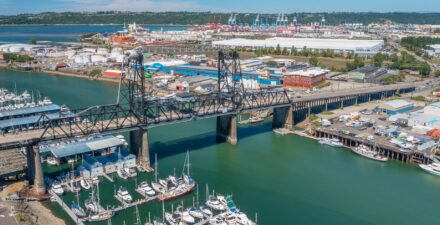
Tideflats Subarea Plan
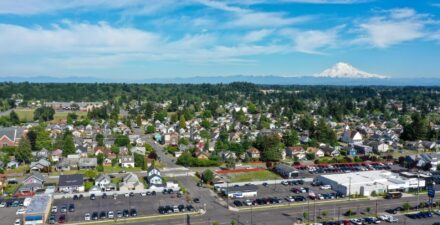
South Tacoma Groundwater Protection District
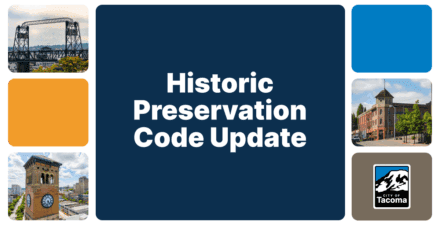
Historic Preservation Code Update
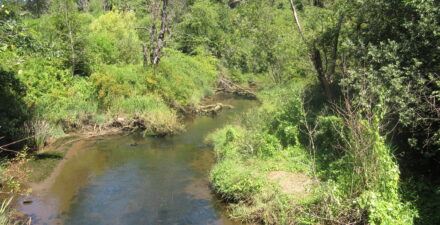
Critical Areas Ordinance Update
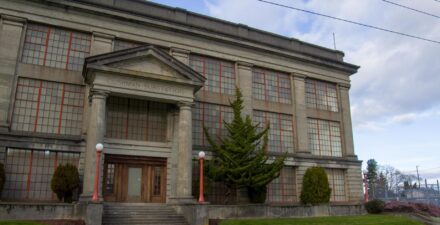
Cushman and Adams Substations Future Use Study

One Tacoma: Comprehensive Plan Update
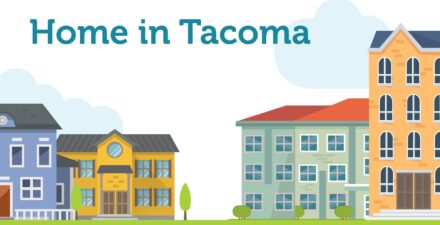
Home In Tacoma
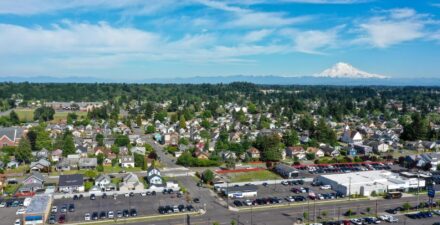
Bridge Industrial Development
More Hot Topics and Projects
-
On April 23, 2024, Tacoma City Council passed Amended Ordinance 28962, establishing a temporary moratorium on the consideration and creation of new local historic overlay districts in residential areas in Tacoma, for a period of one year.
On March 4, 2025, the City Council adopted Ordinance 29022, approving a six-month extension of the existing moratorium, along with a detailed Planning Commission workplan.
Public Hearing Documents
City Council Hearing Notice February 11, 2025
City Council Hearing Notice March 5, 2024Background Documents
Ordinance No 29022
Ordinance No. 28962
Amendment to Ordinance 28962
Resolution No. 41226
Landmarks Preservation Commission Letter to Planning Commission
Planning Commission Recommendation to CouncilReview Schedule
The proposed schedule considers the direction to coordinate the consideration with the Landmarks Preservation Commission. It is proposed by staff that the Planning Commission conduct a hearing and include the Landmarks Commission in the review of testimony. To review the Commission materials and minutes from the meetings below, please visit either the Landmarks Commission web page or the Planning Commission web page.The review schedule is as follows:
Date Forum Subject August 16, 2023 Planning Commission Present moratorium resolution and proposed process and schedule
Set hearing dateSeptember 20, 2023 Planning Commission Public hearing on moratorium October 4, 2023 Planning Commission Debrief on hearing testimony
Summary of issues
Identify key questions for LPC inputOctober 11, 2023 Landmarks Preservation Commission Review testimony
Adopt response to Planning CommissionNovember 15, 2023 Planning Commission LPC feedback presented to Planning Commission
Finalize recommendations to CouncilJanuary 16, 2024 Council Study Session February 6, 2024 City Council
Set Public Hearing dateMarch 5, 2024 City Council Public Hearing on Moratorium March 19, 2024 Council Study Session Hearing Debrief April 16, 2024 City Council First Reading of Ordinance April 23, 2024 City Council Second Reading of Ordinance January 15, 2025 Planning Commission Review Revised Workplan January 28, 2025 City Council Set Public Hearing Date February 11, 2025 City Council Public Hearing on Moratorium Extension February 25, 2025 City Council First Reading of Ordinance to Extend Moratorium for 6 months March 4, 2025 City Council Final Reading of Ordinance to Extend Moratorium for 6 months Background
On June 20, 2023, the City Council adopted Council Resolution 41226, directing the Planning Commission, in coordination with the Landmarks Commission, to conduct a public process to determine if a moratorium on the consideration and creation of local historic districts is warranted, and if so, what the scope and duration should be.
If a moratorium on local historic district creation is adopted, the City of Tacoma will temporarily not consider new local historic district proposals for the time period adopted by Council. Once the moratorium terminates, consideration of future districts will resume.
Tacoma Municipal Code 13.07.060 outlines regulations for the local Tacoma Register of Historic Places and the nomination and designation process for Historic Special Review and Conservation Districts. The Landmarks Preservation Commission and Planning Commission are both responsible for reviewing nominations and making recommendations. In 2022, both bodies reviewed an application to add a district to the Tacoma Register of Historic Places. The Landmarks Preservation Commission made recommendations on April 13, 2022, and the Planning Commission denied the request on November 2, 2022. During their reviews, both commissions noted concerns about the existing historic district designation process and recommended that a review and potential update to the process should be conducted in the earliest possible plan and code amendment cycle.
The requested review is planned to be included in the upcoming 2024 Comprehensive Plan periodic update process. However, in the interim, the City is still able to accept applications for Historic Special Review and Conservation Districts. As noted by Council in the Resolution:
- It takes a great deal of volunteer and staff time to review these requests, and any review at this time may encounter the same concerns that these commissions have already identified and requested the City address.
- It may be beneficial to implement a moratorium until the review can be completed and the changes be put into effect.
The council resolution requests the Planning Commission, in coordination with the Landmarks Preservation Commission, conduct a public process to develop findings of fact and recommendations as to whether a moratorium on nomination and designation of Historic Special Review and Conservation Districts is warranted, and if so, to recommend the scope and duration.
Local Historic District Overlay Moratorium – Frequently Asked Questions
What is the scope of the proposed moratorium?
The proposed moratorium will place a temporary hold on the consideration and creation of new local historic districts for a period of one year, or until code and policy revisions are considered that address recommendations made by the Landmarks and Planning Commissions regarding the historic district review process.
How does Deputy Mayor Hines’ amendment change the scope of the proposed moratorium?
The Planning Commission recommended the moratorium apply to new local historic districts citywide. Deputy Mayor Hines’ amendment limits the moratorium to only apply to areas of Tacoma with the land use designations of Low-Scale Residential, Mid-Scale Residential, High-Density Multifamily, and Airport Compatibility Residential.
What concerns is the moratorium intended to address?
During its recent review of the proposed College Park Historic District, both the Planning Commission and Landmarks Commission made several recommendations for improving the historic district review process.
Specifically, in its decision document, the Landmarks Commission highlighted the following:
- The Historic Comprehensive Plan Element and associated regulatory codes should be reviewed during the next code and policy amendment process to assess and evaluate compatibility with the broad City policy of objectives concerning diversity, equity and inclusion, to identify barriers, gaps in preservation policy, and criteria used by the Commission, and to identify additional tools and incentives for owners and residents of historic properties.
- A review of the historic district designation process to be conducted to clarify the roles and scope of the review by the Landmarks Commission and Planning Commission, and to improve coordination between the two processes.
- The City should identify additional resources to support researching and proactive creation of historic districts and designation of historic buildings, especially in areas that are underserved by historic preservation, in order to improve familiarity with and access to historic preservation land use tools, promote investment in older neighborhoods, and celebrate neighborhood identity and enhance quality of life.
Similarly, the Planning Commission made the following recommendations:
- Comprehensive Plan policies and regulatory code relating to historic districts should be reviewed and amended at the earliest appropriate amendment cycle, to include review of consistencies between historic preservation policies and policies elsewhere in the Comprehensive Plan relating to housing, equity, and sustainability.
- The Planning Commission concurred with the Landmarks Preservation Commission’s recommendation for a review of the code that outlines the historic district designation process, to improve understanding of the respective roles of each commission, and City Council, and to align the process with other similar land use policy reviews.
- The Commission recommended reviewing the utility of fees for design review for properties on the Tacoma Register of Historic Places, including those within locally designated historic districts and individual City Landmarks; particularly if the value to the City is appropriately balanced with the impact to community members.
- For future local historic district proposals, the Planning Commission concurred with the Landmarks Preservation Commission’s recommendation to reduce the burden on property owners and residents within local historic districts by relaxing or reducing design review requirements.
How are local historic districts created?
Under the current code, local historic districts are administered as “overlay zones,” meaning that the historic district requirements exist “on top of” the base zoning for an area. The historic overlay zones contain development regulations intended to protect the historic elements of the district.
To create a local historic district, the City reviews it both as a historic nomination and as a zoning change. A nomination is reviewed by the Landmarks Commission, which assesses the historic and architectural significance and proposed boundaries of the proposed district according to criteria in its code, before making a recommendation to the Planning Commission. The Planning Commission reviews the proposal as a zoning change. If the Planning Commission votes to recommend creation of the district, the recommendation is forwarded to City Council in the form of an ordinance.
How long does it typically take to create a local historic district?
The length of the process can vary depending on many factors, including the research and outreach time needed to create a nomination document, the size of the district, the level of community support, staff and commission capacity, and whether there are specific issues related to the district such as disagreements over boundaries that require resolution. Typically, the process will take one to two years under the current code.
Are there any anticipated local historic district nominations potentially affected by this moratorium, such as in McKinley or South Tacoma?
While there are ongoing historic preservation efforts in many areas of Tacoma, the City is unaware of any pending proposals at this time or any community efforts to this end that are underway.
Will this prevent certain areas of the city from receiving historic tax benefits?
The primary historic tax incentive is the Special Tax Valuation program, which is available for historic rehabilitation projects on buildings within local historic districts and for individual City Landmarks. Presently there are 4 local historic districts and approximately 190 individual landmarks citywide. All properties currently eligible for the Special Tax Valuation program will remain eligible, as will future individual City Landmarks if added to the historic register.
Will the moratorium have an impact on nominations for individual properties to the Tacoma Register of Historic Places?
No, the process for nominating individual properties to the Tacoma Register of Historic Places, which is independent of the historic district review process, would be unaffected by this moratorium.
Will the moratorium have any effect on National Register nominations?
No. Nominations of individual properties and districts to the National Register of Historic Places is administered by the Washington State Department of Archaeology and Historic Preservation, and this process will not be affected by the moratorium.
Will the moratorium have any effect on existing local historic districts?
There are presently 4 locally designated historic districts in Tacoma: the Wedge Neighborhood Historic District (created in 2010), the North Slope Historic District (created in 1994 and expanded in 1996 and 1999), the Union Depot Warehouse Historic District (created in 1983) and the Old City Hall Historic District (created in 1978).
The moratorium will not affect any existing historic districts, nor will it apply to commercial areas proposed for historic district consideration.
Will the moratorium prevent existing districts from being expanded/modifying boundaries of existing local historic districts?
The moratorium specifically applies to new local historic special review and conservation districts. Modifications to the boundaries of districts already established is beyond the scope of this moratorium; consequently, it will not prevent changes to those boundaries.
Can the Planning Commission choose not to consider proposals for historic districts?
Yes, the Planning Commission may elect to not move forward with review of an historic district proposal, if the Commission feels that it does not warrant review under the assessment criteria in code used to evaluate new proposals (Tacoma Municipal Code 13.05.030.B.7). For example, the Planning Commission may decline review if it determines that the proposal or one similar to it has been recently considered by the Commission, or whether review of the proposal is manageable given commission resources and workload. Similarly, the Landmarks Commission must consider a nomination that is complete and meets the submittal requirements, but it is not obligated to take it under formal review or send it to the Planning Commission. In both cases, the proposal must be placed on the respective commission’s agendas once received and determined complete, but neither commission is required take the matter forward.
Will the City’s existing cultural resources protections and demolition review be affected by the proposed moratorium?
No. The areas of the code that govern demolition review and cultural resources review (TMC 13.12.570) are separate from the historic district process and will be unaffected by the moratorium.
Reuben McKnight, Historic Preservation Officer
Email: rmchnigh@tacoma.gov -
A Historic Property Survey was conducted within the South Tacoma Mixed Use Center (MUC) to inventory a sample of historic properties, starting in Fall 2023 and continuing into 2024. Public input was sought to help select which buildings will be documented. All of the survey work, at both the reconnaissance and intensive levels, has been completed, with all buildings/structures over 50 years of age recorded from the public right-of-way.
A walking tour of the neighborhood was held on July 18, 2024, for the community to hear the results of the South Tacoma Way Mixed Use Center Historic Property Survey.
Read the final report (August 2024)The following 10 properties were selected for intensive survey with community input:
- Bridge United Methodist Church, 5601 S. Puget Sound Ave.
- South Tacoma Branch, American Savings and Loan, 3501 S. 58th St.
- Piggly Wiggly Supermarket/Franklin Food Store, 5252 S. Washington St.
- The Opal Tavern/Beer Parlor, 5226 S. Tacoma Way
- Southwell Schwinn’s Cyclery, 5419 S. Tacoma Way
- Ed Garceau Drygoods Store/Department Store, 5423 S. Tacoma Way
- Brown’s Flower Shop, 4734 S. Tacoma Way
- Kenworthy Grain & Milling Co. warehouse, 5436 S. Washington St.
- Newbert Building, 5046-50 S. Tacoma Way
- Automotive garage/Dance hall, 5210-14 S. Tacoma Way
Please send comments/questions to landmarks@tacoma.gov or call Susan Johnson, Historic Preservation Coordinator, at (253) 281-7445.
Background
This inventory project was led by the City of Tacoma’s Historic Preservation Office in an effort to update the city’s inventory of historic and cultural resources. One goal of the inventory is to include thorough public outreach so that we better understand what is important to the community. This project reflects our dedication to equity and antiracism and the inclusion of voices that have been underrepresented.
The project recorded approximately 200 buildings built in or before 1985, similar to the surveys done for the McKinley and Lincoln neighborhoods in 2021 and 2022.
Buildings were documented through digital photography from the public right-of-way along with field observations on construction, materials, function, and architectural features. Historical research was done to address the broad patterns of development for the neighborhood, not individual buildings. Inventory forms were created in the online WISAARD database, maintained by DAHP. Current photos were uploaded with each form. A final public meeting was be held to report back on the project, including the survey findings.
The project was partially funded by a Certified Local Government grant from the Washington Department of Archaeology and Historic Preservation. As such, this project complied with Washington State Standards for Cultural Resource Reporting. At a high level, this project will help the City’s Planning and Development Services office to better understand the historic resources in the South Tacoma neighborhood, for the purposes of planning, research, economic investment, and public information. There is little existing data on historic properties within this neighborhood.
Project Schedule
- October 17, 2023 – Project Kickoff (in-person event) at Parks Tacoma’s STAR Center
- Fall 2023 through Spring 2024 – Research and field documentation
- July/August 2024 – Project wrap-up and public meeting to present findings
Documents
- Map of project area
- Presentation of project overview
-
More information on the Airport Overlay coming soon.
-
With grant support from the Historic Preservation Fund of the National Park Service, Department of the Interior, the City of Tacoma Historic Preservation Program is excited to announce the kick-off of Tacoma’s Black Heritage Survey Project. Building on a similar statewide survey project and the momentum around preserving the Nettie J. Asberry Home in the Hilltop Neighborhood, the Black Heritage Survey of Tacoma will identify and document sites of historic significance, including the addition of one or more sites to the National Register of Historic Places that speak to Tacoma’s unique Black cultural history.
A project kick-off meeting was held on August 30, 2023 at the Tacoma campus of The Evergreen State College, located at 1210 6th Avenue. The survey project has identified five sites of significance to record and one to nominate to the National Register of Historic Places. More details will be shared through a project update to City Council in February (pending agenda confirmation), 2025.
The National Park Service’s Underrepresented Community Grant Program is intended to diversify the nominations submitted to the National Register of Historic Places to include communities that are currently underrepresented.
This project is a collaboration of the National Park Service, the Washington State Department of Archaeology and Historic Preservation, the City of Tacoma, Evergreen Tacoma, and Historic Tacoma and other community partners.